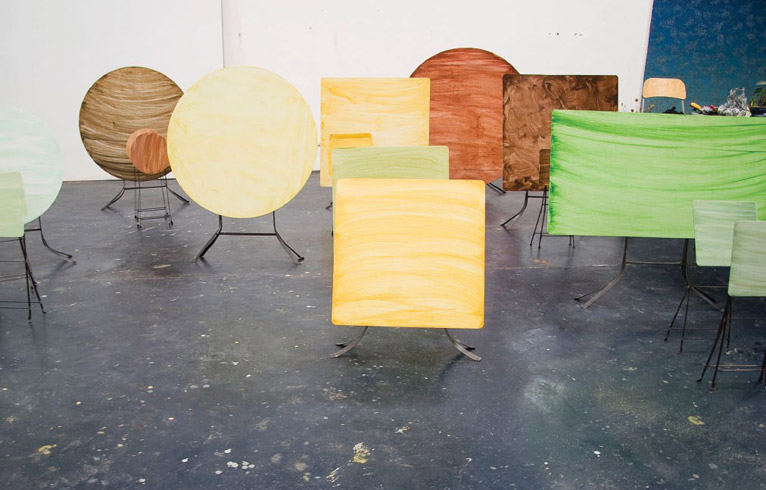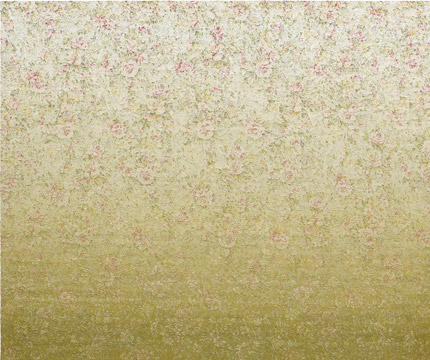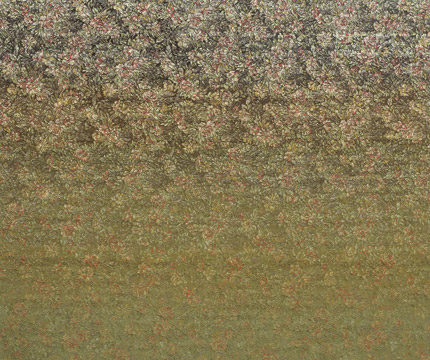LIANG YUANWEI IN BLOOM
| February 15, 2011 | Post In LEAP 7

“I ask it be extinguished / This crude iron light / The light of lovers / The light of the sun.” Such goes the first line of the poet Hai Zi’s work I Ask: Rain. According to Liang Yuanwei, this “crude iron light” leaves a biting sensation in her mouth. Sometimes words and fleeting images can produce such intense sensations; this isn’t news to anybody. But then again, not everyone can tap into these powerful sensory experiences. And with her recent solo exhibition at Beijing Commune, “Golden Notes,” Liang’s treatment of “light” leaves a deep impression on all who enter the gallery.
Liang Yuanwei’s 2008 series of paintings “A Piece of Life” compiled works produced over a long span of time. The canvases seemed more like silk and satin, their graphics like decorative, geometric designs, practiced experiments. The exhibition contained more than thirty works, with the strokes, color, and compositions all distinct. In “Golden Notes” we can see that she abandoned many of these motifs. After general questions arose some years ago, she had no choice but to rely on her own feelings and judgment, leaning in one particular direction and learning along the way as she confronted the obstacles and doubts of others. Starting in 2009, Liang began to create diptychs and triptychs. What aroused her interest was that like this, the interaction between colors could engender new “realms of color.” The background colors of the upper halves of two paintings could be entirely different, while the lower halves could be completely identical. Using short strokes and a myriad of complementary colors, the effect that up close, the paintings were brightly colored, while from afar, there was a floating layer of golden mist on top.
Her current show has spurred discussions on both “formalism” and “aesthetics,” issues that take strong positions in her work. To a certain degree, the joy of viewing has been suppressed. Sealed off from the inside. Overtly material? Actions lacking logic? Are her demands of form and beauty simply a “conservative return to the traditional,” or are they not? “I do not believe that there is any talk of a ‘return’ to ‘visual aesthetics,’ or more concretely speaking, ‘formalist language,’ on the international art world stage; there was never a departure in the first place. Although postmodernism has its doubts about ‘retinal art,’ explorations into form are not only yet to find a conclusion, but have always intersected with conceptual art. The two make use of each other.” Liang doesn’t endorse art’s theory of evolution. Is formalism of any value, and if so, where does that value reside? Her method of choice is to realize through action, even going so far as to conscientiously avoid the extremities or arbitrariness that may appear within. “I must not put myself in a cynical position, I must ask questions through my actions, and it doesn’t matter whether they are definitively right or wrong.”

She goes on to quote Nilima Sheikh to illustrate her idea of beauty: “Maybe in the way that I use beauty, it is also a critique of people who see beauty as external to expression, which fostered closures, and so, guilt. It is a critique of an attitude of decontextualizing beauty from language or thinking that beauty is external or dispensable. It is also a critique of rules.” But the Liang Yuanwei of today can’t speak as sincerely as Sheikh, for after the works in this exhibition necessarily and accurately address one specific question in pursuit of her own motifs, they manifest themselves from that position.
This time around, Liang Yuanwei only used flowers in her graphics. But whether or not the flowers in her work are “feminine” or “meticulously feminine” seems to miss the point. For the characteristically feminine, going from clash and resistance to strategic employment and then to re-examination and relatively harmonious compatibility, “feminization” can no longer be so simply embodied on canvas. It permeates every one of the artist’s movements—she uses restraint and reason in her working methods to control her own feelings and emotions, attempting to give the latter room to flow freely within the frame. Liang mentions how in the creative process she strives to retain her initial feelings, which she gradually approaches by very rigidly finishing her paintings one line at a time.
In her exhibition “Picture of Early Spring,” this feeling is clearly manifested as the scent of early spring. But unlike “Golden Notes,” “Picture of Early Spring,” as part of Taikang Space’s “51m²” project, departs from the frame of the painting and enters another space. In “Picture of Early Spring” an extension of this logic can be seen— if one were to take each folding chair used in the series as an independent “unit,” the work itself would comprise a complete set of spatial relations. In classical painting, the distant mountains and forests form the grains and colors on the top of the chair, weak and simple, yet after adding layers, a new structure forms, with a new sort of interactivity to remind us of the “realms” in her paintings.

As a vehicle, the chairs allow this exploration of form to materialize. The imprint of daily life that the chairs contain, in Liang Yuanwei’s eyes, has its own meaning, capable of stirring emotions. She needs this “actuality” to keep her work from drifting away, or relying too heavily on emotion. This “actuality” is a choice, and an incredibly delicate one at that, as it rings of China’s Open Door Policy. However, we can sometimes see a rejection of narrativity and conceptualization in the work. The politics of beauty do not pass through the realm of aesthetics to make political claims. The surrounding environment exerts a subtle influence over the artist, and, after passing through individual understanding and expression, is manifested as form itself. For Liang, it is more crucial to forge ahead than to follow, to transcend and go against the tide. In this way, her motifs gain clarity,
and her point of view is expressed ever more concretely, ever more forcefully. And thus the ability to build those “realms” becomes stronger, crossing over opposition and entering a state of calm and free expression.
Maybe the attitude of resistance Liang Yuanwei holds towards narrativity and conceptualization is a less intimate, less genuine sort of rejection. Our individual perception and thought processes, as well as interests and tendencies, leave us with certain inclinations that form certain working methods. How to move forward, instead of staying put in one place or obsessed with certain results relies on the knowledge and judgment of the artist. It is difficult to say that there is a “correct” or “right” art, but trends, to be sure, exist. For Liang, forging ahead is even more important than following, transcending, or going against the tide. Although this brings with it its own pressure, in terms of form and content, thought and action, the open and the closed, separation and intervention, she still finds much contradiction, much amiss. Yet amidst this contradiction, perhaps the energy formed by the clash of different forces at work is actually quite formidable.


